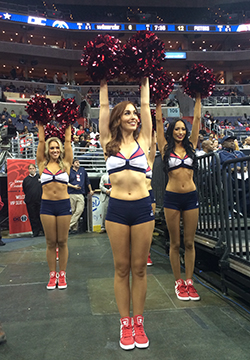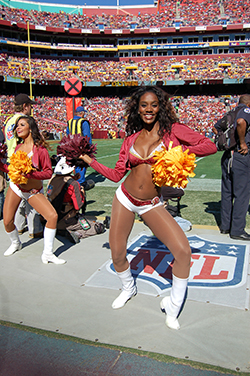The other lives of cheerleaders
Simply listening to Julia, a cheerleader for the NBA’s , describe her weekly routine is exhausting. She rattles off a typical schedule for the team’s cheer squad: “Game on Monday, practice Tuesday, game on Wednesday, practice Thursday, maybe a night off, game Saturday, practice on Sunday and another game on Monday.”
 Julia leads a cheer by the Wizards Girls during a game in 2014.Image courtesy of Washington Wizards
Julia leads a cheer by the Wizards Girls during a game in 2014.Image courtesy of Washington Wizards
And, for Julia, this demanding schedule is merely half of her story. Like nearly all professional cheerleaders, she also has a full-time job on top of her duties on the sidelines. “I don’t think people realize the double lives we lead,” says Julia, who is a producer and reporter for and holds a master’s degree in environmental science.
Counting nurses, accountants and lawyers among their ranks, cheerleaders like Julia and Teleza, a cheerleader for the NFL’s who teaches middle-school science and math, devote an equal amount of time and effort to cheering and their careers. (In keeping with team policy, neither woman can reveal her last name.) In doing so, they are able not only to fulfill their personal and professional dreams and ambitions but also to serve as role models for younger generations.
Simply by being who they are, women like Julia and Teleza represent a nontraditional type of advocacy that is critical, according to Darlene Cavalier, the founder of the STEM outreach organization . For better or for worse, cheerleaders have the aura of glamour and glitter, which “allows us to tap into audiences that are almost impossible to (otherwise) reach,” says Cavalier. “There’s no denying the long lines of little girls who come up to them at events who want signed autographs.”
Julia concurs: “Shiny pompoms always have a way of capturing young girls’ attention.”
Pursuing science and dance
Teleza and Julia both say that their passion for cheerleading developed when they were little girls, brought about through an interest in dancing. Teleza remembers that when she was a child, “my mother immediately threw me into dance classes.” Following a move to the Washington, D.C., area from Montreal, Canada, she trained extensively at the National Ballet Institute for the Arts and The Washington School of Ballet, and joined her high-school dance team.
Inspired by her pediatrician, Teleza also developed a strong interest in science and medicine. She was so enamored of biology in high school that she decided to major in the subject (and minor in chemistry) at Howard University with plans to attend medical school. Teleza also kept up with her dancing, joining the school’s , which performs dance routines at football games.
During her senior year, encouraged by former and current Redskins cheerleaders with whom she was friends, Teleza tried out for the Redskins’ cheer squad. In her first tryout, she made the team, and she has been a cheerleader for the Redskins for three seasons.
Julia similarly was introduced to dancing at a young age. “The irony was when I was really little, I didn’t like going to ballet classes, but I wanted to be a cheerleader,” she recalls. “My mom said, ‘If you want to be a cheerleader, you have to go to ballet classes.’” So Julia did ballet throughout her childhood while also developing a burgeoning interest in science, inspired by her father, a chemical engineer at Louisiana State University.
After obtaining a degree in marine biology from Duke University, Julia went on to pursue a master’s degree in environment science management at the University of California, Santa Barbara, where she also ended up taking journalism classes. Deciding to pursue a journalism career after graduating, Julia arrived in Washington, D.C., in 2010 for an internship at PBS NewsHour. She ended up being hired on full time and has been there since.
For a few years, dancing and cheerleading had taken a back seat. But in 2011, Julia watched one of her former Duke cheerleading squad members, at that point a consultant at Accenture, successfully audition to be a cheerleader for the New York Knicks. “I started thinking that if she could balance both – a real stressful career and cheerleading – maybe that’s something I can do,” she says. Julia is now in her fourth season as a Wizards Girl and has served as one of the team captains for two years.
“Career suicide”
 Teleza has been a cheerleader with the Washington Redskins for three seasons.Image courtesy of Emily Rawdon
Teleza has been a cheerleader with the Washington Redskins for three seasons.Image courtesy of Emily Rawdon
Both Julia and Teleza say that they were nervous initially about how they would be perceived in the workplace once their cheerleading personas were uncovered. Such apprehension is to be expected, says Cavalier. She points out that a generation ago, for a female scientist or engineer to admit to cheerleading “would absolutely have been career suicide.”
However, Julia and Teleza both found that they had nothing to worry about. At first, Julia told only her boss at PBS about her cheerleading, concerned that men would behave inappropriately toward her and that women would judge her.
But as she has become more open about being a Wizards Girl, Julia has been delighted by the responses. “People are taken aback and surprised that I’m able to do almost two full-time jobs at once and that I’m talented enough to have made the team,” she says.
She notes with delight that these conversations usually bring up one question: “They wonder, ‘Oh, can I get tickets to the gam


